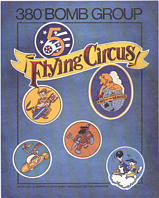 |
380th Bomb
Group Association
|
Compiled by Barbara J. Gotham Sue Goble September 1999 |
FOREWORD
 |
380th Bomb
Group Association
|
Compiled by Barbara J. Gotham Sue Goble September 1999 |
FOREWORD
This publication is Part IV of the overall document, WE WENT TO WAR, a series of historical data reports on the 380th Bombardment Group (Heavy), Fifth Air Force, United States Air Forces. The 380th served in the South West Pacific Area during World War II. They served in the Northern Territory, Australia (under overall Australian command) and periodically in New Guinea from May 1943 — February 1945. Then they served in The Philippines (Mindoro) from March — August 1945 and had moved to Okinawa by war's end.
We are particularly indebted to Ms. Sue Goble of the Force Integration Division, U.S. Total Army Personnel Command, United States Army, Alexandria, Virginia, for her most willing service in providing us annotated copies of the pertinent U.S. Army personnel documents which defined the MOS/SSN procedure during World War II.
Without her outstanding help this whole series of reports would be much less complete than they can be now. We have taken the liberty to add her name to our Compilers List of this Part as a small token of our thanks to her. We hope she approves and accepts our heartfelt thanks.
Barbara J. Gotham Theodore J. Williams
INTRODUCTION
Any military unit of the size of a World War II Heavy Bombardment Group requires a very large number of different personnel skills among its approximately 8,000 personnel. This is particularly so when the unit must serve in an isolated area far from its sources of supply and assistance from other related military units. Such was the 380th Bomb Group which served in the Northern Territory of Australia, New Guinea, and The Philippines (Mindoro) during World War II.
Fortunately, the United States Army had foreseen the need for such capability and had instituted an elaborate personnel classification and training system to supply such a need. The occupational skills and specialties needed have been recorded as MOS/SSN numbers (Military Occupational Specialties/Service Specialty Numbers) and are described in a series of Army Regulations and Technical Manuals.
We, the compilers of this series of documents, have, to the extent possible, listed the MOS/SSN number and title for each individual on our roster. It is noted that the assignment of MOS numbers as used here seems to bear little relationship to related occupational skills.
The information that made this analysis possible was supplied by Ms. Sue Goble of the Force Integration Division, U.S. Total Army Personnel Command, United States Army, Alexandria, Virginia. She supplied us with copies of the pertinent pages from the following documents:
Army Regulations, AR 615-26, Sections 7 and 17, Civilian and Military Occupational Specialists (Date Unknown), and
Technical Manual, TM12-427, Section IV, Specifications for Military Occupational Specialties, dated 30 June 1945,
and other documents as needed. This document would have been impossible without this help.
The MOS/SSN numbers changed several times during World War II as indicated by the redundancy in Occupational Specialty Names used here and the occasional double use of some numbers. Such numbers were radically revised during the 1960s and since, and current usage is radically different than that of World War II, again highlighting the value of the information supplied by Ms. Goble.
This document is divided into five sections as follows:
Section 1: Alphabetical Officer MOS Listings
Section 2: Numerical Officer MOS Listings
Section 3: Alphabetical Enlisted MOS Listings
Section 4: Numerical Enlisted MOS Listings
Section 5: Division of MOS Designations by Department Assigned
The Departments are:
In all cases, both MOS Number and Title are presented. Many specialties are needed in more than one Department. This is indicated when known. We have not attempted to include the specifications of each of the MOS/SSNs presented because of the bulk involved and because the titles themselves are generally quite explanatory.
Glossary of Abbreviations and Acronyms Used
The authors regret any mistakes that may have crept into this compilation and we take full responsibility for such. We will welcome any comments or corrections from the readers of this book and the other parts of this compilation, and will make every effort to correct them. Therefore, we hope you will let us know of any such errors.
For a list of the errors found to date, please click here.
Every attempt has been made to get permission to use photographs, drawings, information, etc., when the sources were known. If copyrighted material appears here, please let us know so permission can be requested and credit given. If you have any photos, corrections, or other information to add to this history, please send email to Barbara Gotham at 380th.ww2@gmail.com or use our Comment Form.
We will incorporate all corrections and additional data which we receive in this compilation as maintained at this website.
ISBN 0-9672447-3-0
Library of Congress Catalog Card Number 99-73366
Copyright © 1999 by Theodore J. Williams
All rights reserved. No part of this publication may be reproduced, stored in a retrieval system or transmitted in any form or by any means, mechanical, photo-copying, recording, or otherwise, for commercial purposes, without the prior written permission of the publisher. However, private use for historical research or related purposes is hereby granted on condition that credit be given to this publication and its authors.
Published by:
Theodore J. Williams
West Lafayette, IN USA
Printed in the United States of America.
Glossary of Abbreviations and Acronyms Used
Last updated: 27 August 2015